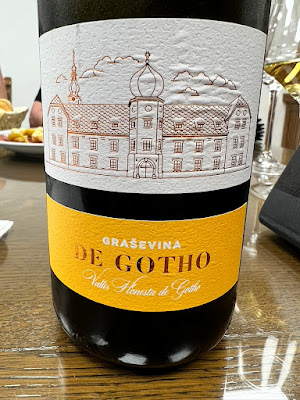It seems like the Croatian wine industry is still in the early stages of realizing the full potential of this grape. And much of the the rest of the world still lacks an understanding of the delights of Croatian Graševina. My own first experience with this grape, back in 2009, was an example from Austria, in a blend of a dessert wine. I wouldn't taste another example of this grape until my 2019 trip to Croatia. However, it wasn't until my 2022 Croatian trip that I tasted numerous examples of Graševina wine, acquiring a true appreciation for it.
There was a Graševina seminar in Osijek during our visit, including a seminar: "Grasevina: Yesterday, Today and Tomorrow." There were about 60 people in the seminar, but as it was all in Croatian, there was little I could understand. However, I did get a brief opportunity to speak with Professor Edi Maletic, Head of the Department of Viticulture and Enology at the University of Zagreb. He noted that Graševina is a versatile grape, that is largely unknown to most Americans. A major point of the seminar was that Graševina needs more marketing and publicity, and that the wineries and associations need to take the primary responsibility for doing so. It certainly is the case that many Americans have little exposure to Graševina.
Graševina is known by an assortment of others names, and its best known name, especially in Germany and Austria, is Welschriesling. A few of its other synonyms include Olascs Rizling in Hungary, Riesling Italico in Italy, and Laški Rizling in Slovenia. Interestingly, despite its name, the grape has actually no connection to the Riesling grape. "Welsch" means "foreigner," so it seems likely that the grape didn't originate in Germany or Austria.
The origins of Graševina are uncertain, with a few different regions being offered as possible sources, such as northern Italy or even the Champagne region of France. Famed wine writer Jancis Robinson believes it likely came from Croatia or the Danube region. So, it is possible that Graševina is an indigenous Croatian grape. Whatever its origins, Graševina has been firmly embraced by Croatian winemakers, and they are showing its vast potential.
Within Croatia, the grape was previously known as Grašica, which means "green peas," referring to the appearance of the grapes at a certain point during their growth cycle. Its current name, Graševina, was due to the work of Bogoslav Šulek, a famous Croatian linguist and lexicographer. Croatia currently recognizes 4 clones of Graševina, each recommended for specific soils.
Graševina is a late harvesting grape with a green-yellow color and it's also high-yielding, although some wineries harvest far less per hectare, seeking quality over quantity. There are some older vineyards in Slavonia, with Graševina vines of over 30 years old, these older grapes often showing great concentration and elegance.
Its flavor profile often contains floral elements, and flavors of green apple, peach, citrus, and even almonds. Based on its terroir, some Graševina may also showcase a mineral aspect. Its high acidity can produce some excellent Sparkling Wines too. The profile of Graševina wines also depends on the production methods, and numerous wineries have been experimenting with Graševina to produce an even wider variety of profiles. For example, the grape might be left on the lees for a longer time, or aged in Slavonian oak, or even Acacia barrels.
Graševina can age well too, and as I mentioned previously, Vina Belje has over 60 different vintages of Graševina in their cellars. The older examples of Graševina that I tasted were generally delicious, with lots of complexity, and definitely evidence of how well this grape can age. Overall, I found many impressive and different expressions of Graševina.
As for food pairings, it was often suggested that Graševina pairs well with seafood, cured meats and cheeses. Its high acidity definitely makes it a better food pairing, and I also believe it would pair well with other lighter dishes, such as chicken. However, much also depends on the specific style of Graševina, where some of the wines might even pair well with heartier dishes, from pork to beef. Obviously, the sweeter styles, such as Late Harvest Graševina, would work well with a variety of desserts. And there's plenty of Graševina wines which can simply be enjoyed on their own.
There was also a small tasting event that accompanied the seminar and I had a short time to sample more examples of Graševina, and my four favorites are below.
The 2019 Iločki Podrumi Graševina, with a 13% ABV, was an interesting wine, with greater depth, more subdued fruit flavors, and some honey notes. A lengthy finish, good acidity, and overall delicious.
The 2020 Apolitico Graševina, with a 13% ABV, is from a mix of Graševina grapes from young and older vineyards, where the harvest is about half the usual amount. It sees no oak, and I found it to be fresh and crisp, with notes of apples and pear, with a savory aspect and a nice depth to it. Again, another very delicious wine.
The 2020 Pinkert Grasevina, with a 13% ABV, was fresh, dry and crisp, with rich flavors of apple, some floral aspects, and a hint of honey, especially on the finish. Easy drinking but far from simple.
The 2019 Pinkert Single Barrel Graševina, with a 13% ABV, was impressive. Pure and clean flavors of apples, pear and mild floral notes. Fresh, crisp, complex and elegant, it was absolutely delicious, and would be perfect for seafood.
You can search my Croatian posts for many more reviews of a variety of Graševina wines. Continued research and experimentation are ongoing with this grape, and its quality will continue to improve over time. For now, I strongly recommend you seek out Graševina wines and learn more about this delicious and fascinating grape. You could even drink different Graševina wines over the course of a dinner, starting with a Sparkling Graševina, moving onto some still Graševina as well as an amber Graševina, and then ending with a Graševina dessert wine.
The 2020 Apolitico Graševina, with a 13% ABV, is from a mix of Graševina grapes from young and older vineyards, where the harvest is about half the usual amount. It sees no oak, and I found it to be fresh and crisp, with notes of apples and pear, with a savory aspect and a nice depth to it. Again, another very delicious wine.
The 2020 Pinkert Grasevina, with a 13% ABV, was fresh, dry and crisp, with rich flavors of apple, some floral aspects, and a hint of honey, especially on the finish. Easy drinking but far from simple.
The 2019 Pinkert Single Barrel Graševina, with a 13% ABV, was impressive. Pure and clean flavors of apples, pear and mild floral notes. Fresh, crisp, complex and elegant, it was absolutely delicious, and would be perfect for seafood.
You can search my Croatian posts for many more reviews of a variety of Graševina wines. Continued research and experimentation are ongoing with this grape, and its quality will continue to improve over time. For now, I strongly recommend you seek out Graševina wines and learn more about this delicious and fascinating grape. You could even drink different Graševina wines over the course of a dinner, starting with a Sparkling Graševina, moving onto some still Graševina as well as an amber Graševina, and then ending with a Graševina dessert wine.










No comments:
Post a Comment